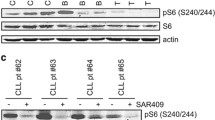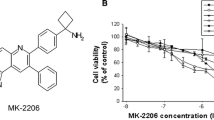Abstract
The novel small molecule ingenol 3-angelate (PEP005) has been shown previously to induce apoptosis in leukaemic cell lines and primary AML cells, an effect that requires the expression of protein kinase C-delta (PKCδ). Here we have investigated signalling events downstream of PKCδ that determine sensitivity of AML cells to PEP005. We show that activation of ERK1/2 MAP kinase occurred in both sensitive and resistant cells and that induction of apoptosis required sustained signalling through the ERK1/2 pathway. Inhibition of ERK1/2 signalling using the MEK inhibitor PD98059 inhibited PEP005-induced apoptosis and activation of ERK1/2 was shown to occur downstream of PKC activation. The data show that PEP005-induced apoptosis is both PKC and ERK1/2 dependent and indicate that chronic activation of ERK1/2 in leukaemic cells delivers a pro-apoptotic rather than a proliferative or survival signal.






Similar content being viewed by others
References
Ogbourne SM, Suhrbier A, Jones B et al (2004) Antitumor activity of 3-ingenyl angelate: plasma membrane and mitochondrial disruption and necrotic cell death. Cancer Res 64:2833–2839
Kedei N, Lundberg DJ, Toth A, Welburn P, Garfield SH, Blumberg PM (2004) Characterization of the interaction of ingenol 3-angelate with protein kinase C. Cancer Res 64:3243–3255
Hampson P, Chahal H, Khanim F et al (2005) PEP005, a selective small-molecule activator of protein kinase C, has potent antileukemic activity mediated via the delta isoform of PKC. Blood 106:1362–1368
Cozzi SJ, Parsons PG, Ogbourne SM, Pedley J, Boyle GM (2006) Induction of senescence in diterpene ester-treated melanoma cells via protein kinase C-dependent hyperactivation of the mitogen-activated protein kinase pathway. Cancer Res 66:10083–10091
Choi BH, Hur EM, Lee JH, Jun DJ, Kim KT (2006) Protein kinase Cdelta-mediated proteasomal degradation of MAP kinase phosphatase-1 contributes to glutamate-induced neuronal cell death. J Cell Sci 119:1329–1340
Pan J, Singh US, Takahashi T et al (2005) PKC mediates cyclic stretch-induced cardiac hypertrophy through Rho family GTPases and mitogen-activated protein kinases in cardiomyocytes. J Cell Physiol 202:536–553
Chang L, Karin M (2001) Mammalian MAP kinase signalling cascades. Nature 410:37–40
Robinson MJ, Cobb MH (1997) Mitogen-activated protein kinase pathways. Curr Opin Cell Biol 9:180–186
Dhillon AS, Hagan S, Rath O, Kolch W (2007) MAP kinase signalling pathways in cancer. Oncogene 26:3279–3290
Towatari M, Iida H, Tanimoto M, Iwata H, Hamaguchi M, Saito H (1997) Constitutive activation of mitogen-activated protein kinase pathway in acute leukemia cells. Leukemia 11:479–484
Wu J, Wong WW, Khosravi F, Minden MD, Penn LZ (2004) Blocking the Raf/MEK/ERK pathway sensitizes acute myelogenous leukemia cells to lovastatin-induced apoptosis. Cancer Res 64:6461–6468
Strniskova M, Barancik M, Ravingerova T (2002) Mitogen-activated protein kinases and their role in regulation of cellular processes. Gen.Physiol Biophys 21:231–255
Kyosseva SV (2004) Mitogen-activated protein kinase signaling. Int Rev Neurobiol 59:201–220
Iida M, Towatari M, Nakao A et al (1999) Lack of constitutive activation of MAP kinase pathway in human acute myeloid leukemia cells with N-Ras mutation. Leukemia 13:585–589
Telford WG, King LE, Fraker PJ (1994) Rapid quantitation of apoptosis in pure and heterogeneous cell populations using flow cytometry. J Immunol Methods 172:1–16
Serova M, Ghoul A, Benhadji KA et al (2008) Effects of protein kinase C modulation by PEP005, a novel ingenol angelate, on mitogen-activated protein kinase and phosphatidylinositol 3-kinase signaling in cancer cells. Mol Cancer Therapy 7:915–922
Juliano RL, Ling V (1976) A surface glycoprotein modulating drug permeability in Chinese hamster ovary cell mutants. Biochim Biophys Acta 455:152–162
Burnett AK (2001) Introduction: modern management of acute myeloid leukemia. Semin Hematol 38:1–2
Lee JT Jr, McCubrey JA (2002) The Raf/MEK/ERK signal transduction cascade as a target for chemotherapeutic intervention in leukemia. Leukemia 16:486–507
Milella M, Kornblau SM, Estrov Z et al (2001) Therapeutic targeting of the MEK/MAPK signal transduction module in acute myeloid leukemia. J Clin Invest 108:851–859
Bhat NR, Zhang P (1999) Hydrogen peroxide activation of multiple mitogen-activated protein kinases in an oligodendrocyte cell line: role of extracellular signal-regulated kinase in hydrogen peroxide-induced cell death. J Neurochem 72:112–119
Wang X, Martindale JL, Holbrook NJ (2000) Requirement for ERK activation in cisplatin-induced apoptosis. J Biol Chem 275:39435–39443
Greene LA, Tischler AS (1976) Establishment of a noradrenergic clonal line of rat adrenal pheochromocytoma cells which respond to nerve growth factor. Proc Natl Acad Sci USA 73:2424–2428
Huff K, End D, Guroff G (1981) Nerve growth factor-induced alteration in the response of PC12 pheochromocytoma cells to epidermal growth factor. J Cell Biol 88:189–198
Heasley LE, Johnson GL (1992) The beta-PDGF receptor induces neuronal differentiation of PC12 cells. Mol Biol Cell 3:545–553
Nguyen TT, Scimeca JC, Filloux C, Peraldi P, Carpentier JL, Van OE (1993) Co-regulation of the mitogen-activated protein kinase, extracellular signal-regulated kinase 1, and the 90-kDa ribosomal S6 kinase in PC12 cells. Distinct effects of the neurotrophic factor, nerve growth factor, and the mitogenic factor, epidermal growth factor. J Biol Chem 268:9803–9810
Traverse S, Gomez N, Paterson H, Marshall C, Cohen P (1992) Sustained activation of the mitogen-activated protein (MAP) kinase cascade may be required for differentiation of PC12 cells. Comparison of the effects of nerve growth factor and epidermal growth factor. Biochem J 288(Pt 2):351–355
Chen JR, Plotkin LI, Aguirre JI et al (2005) Transient versus sustained phosphorylation and nuclear accumulation of ERKs underlie anti-versus pro-apoptotic effects of estrogens. J Biol Chem 280:4632–4638
Sharrocks AD (2001) The ETS-domain transcription factor family. Nat Rev Mol Cell Biol 2:827–837
Fambrough D, McClure K, Kazlauskas A, Lander ES (1999) Diverse signaling pathways activated by growth factor receptors induce broadly overlapping, rather than independent, sets of genes. Cell 97:727–741
Greenberg ME, Greene LA, Ziff EB (1985) Nerve growth factor and epidermal growth factor induce rapid transient changes in proto-oncogene transcription in PC12 cells. J Biol Chem 260:14101–14110
Murphy LO, Smith S, Chen RH, Fingar DC, Blenis J (2002) Molecular interpretation of ERK signal duration by immediate early gene products. Nat Cell Biol 4:556–564
Murphy LO, MacKeigan JP, Blenis J (2004) A network of immediate early gene products propagates subtle differences in mitogen-activated protein kinase signal amplitude and duration. Mol Cell Biol 24:144–153
Morrison P, Saltiel AR, Rosner MR (1996) Role of mitogen-activated protein kinase in regulation of the epidermal growth factor receptor by protein kinase C. J Biol Chem 271:12891–12896
Ueda Y, Hirai S, Osada S, Suzuki A, Mizuno K, Ohno S (1996) Protein kinase C activates the MEK-ERK pathway in a manner independent of Ras and dependent on Raf. J Biol Chem 271:23512–23519
Acknowledgements
Supported by funds from Peplin Ltd and the European Commission (LSHB-CT-2004-503467). E.E. and O.B. were supported by the Norwegian Cancer Society.
Conflict of interest statement
The authors declare no conflict of interest.
Author information
Authors and Affiliations
Corresponding author
Rights and permissions
About this article
Cite this article
Hampson, P., Wang, K., Milverton, L. et al. Kinetics of ERK1/2 activation determine sensitivity of acute myeloid leukaemia cells to the induction of apoptosis by the novel small molecule ingenol 3-angelate (PEP005). Apoptosis 15, 946–955 (2010). https://doi.org/10.1007/s10495-010-0507-7
Published:
Issue Date:
DOI: https://doi.org/10.1007/s10495-010-0507-7




